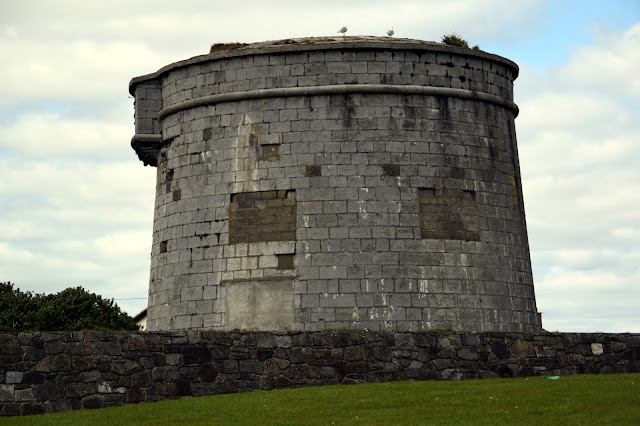Skerries is another of North County Dublin’s sea-side towns located
31km (19mi) north of Dublin City Centre. It is a prosperous fishing town
with much on offer to tourist. Skerries is now one of Dublin’s most
desirable resedential areas due to its character and its lovely seaside.
Skerries’ long sandy beach, an ideal spot for safe bathing for adults
and children alike, is watched by lifeguards during the summer months.
It is joined to the Red Island Scenic Park, with excellent views and a
children’s playground.
Skerries has five islands off its coast. These are Shenick Island, St Patrick's, Colt and Rockabill. Rockabill is in fact two islands, "The Cow" and "The Calf",separated by a narrow channel. There is also Red Island, which is a tied island.
The town itself is built around two long streets - Strand Street and
Church Street and between the surrounding hills of North Fingal and
low-lying beaches. Red Island, Mill Hill, Hillside, The public Ardgillan
Park and Demesne, Barnageera and to a lesser extent Baldungan Castle
are high points on which you can look over the town.
Rockabill has the largest numbers of
breeding roseate terns in Europe. It is also the farthest away from the
town and has a lighthouse. On Shenick Island can be found a Martello
tower, one of a number of defensive towers erected during the Napoleonic
era along the Irish coast by the British.
Shenick is accessible on foot at the lowest tides, but this is
inadvisable, due to the relatively rapid fill caused by the turning
tide. The other islands are harder to reach, but it is possible by boat.
Red Island also has a Martello Tower. St Patrick's Island is so called
because this is where the Irish patron saint is reputed to have landed
and begun his mission to convert the country to Christianity.
Early writers tell how an island off Skerries was used as a landing
place for an invasion, which happened in the second century. This island
was either Shenick or Red Island, which would have been a tidal island
at the time. When the invaders landed, they formed ranks and at low tide
marched to the mainland, where they were promptly defeated at the
ancient settlement of Knocknagin, north of Balbriggan. The islands were previously known as the Islands of Cor possibly after the original inhabitants.
As noted, in 432 AD, St. Patrick is reputed to have landed on Church Island, and according to the Annals of Inisfallen Saint Mochonna founded a monastery shortly afterwards.
In 797 AD, the Vikings (or Danes) carried out one of their earliest raids in Ireland when they plundered the monastery
on Church Island. As the origin of the name is Norse and many
localities have Norse-based names, it is safe to assume the Vikings did
settle and occupy the area. Sitric, who was a son of a Dane called
Murchard, re-founded the monastery on Church Island in 1120. He
dedicated it to St. Patrick, the Apostle of Ireland. By this time, the
Danes who had settled in Ireland had become Christians.
In 1148, Saint Malachy, Archbishop of Armagh, arranged a synod on St. Patrick's island to settle differences between the Irish Christians and the Pope. Fifteen bishops, two hundred priests and other clergy were present.
In 1320, the manor of Skerries was granted to Sir Michael le Veel; his descendants Anglicised their name to Calf.
The Prior of Holmpatrick received permission to build a pier in 1496 from King Henry VII. At this time, Skerries was the property of the monastery of Holmpatrick and was known as the Port of Holmpatrick.
In 1565, after the Reformation,
the monastery and its lands became the property of Thomas Fitzpatrick.
In 1605 the manor and lands of Holmpatrick was granted to the Earl of Thomond. In 1721 the last Earl sold the manor and lands, including the town of Skerries, to the Hamilton family of Hacketstown.
In 1897, the Hamilton family were granted the title of Lord
Holmpatrick. Comparisons between maps of Skerries drawn in 1703 and 1760
suggest that the Hamilton family was responsible for setting out the
streets of the town as they are today. Between 1863 and 1865 a monument
to the memory of James Hans Hamilton, the local landlord and MP, was
erected in Skerries.
After the 1916 rising, a British
destroyer landed troops at Skerries to help the Dublin garrisons
suppress the rising. 200 men of the North Staffordshire Regiment
landed under the command of Captain Clay. To try to impede their
progress to Dublin, local rebels blew up the bridge over the railway in
Donabate. During the Irish Civil War in 1922, Harry Boland was mortally
wounded while being taken into custody by Irish Free State forces at the
Skerries Grand Hotel.
[wikipedia]




















No comments:
Post a Comment